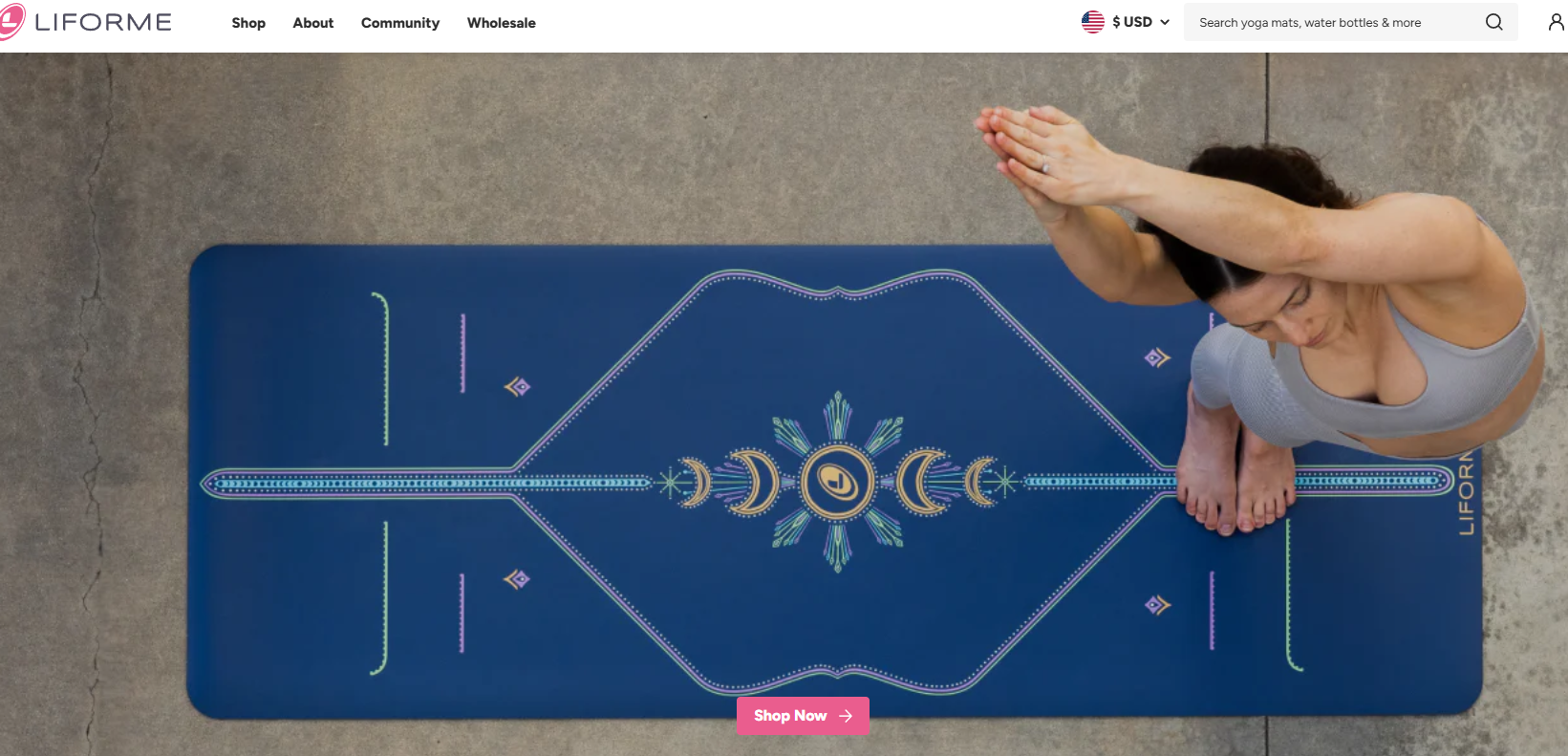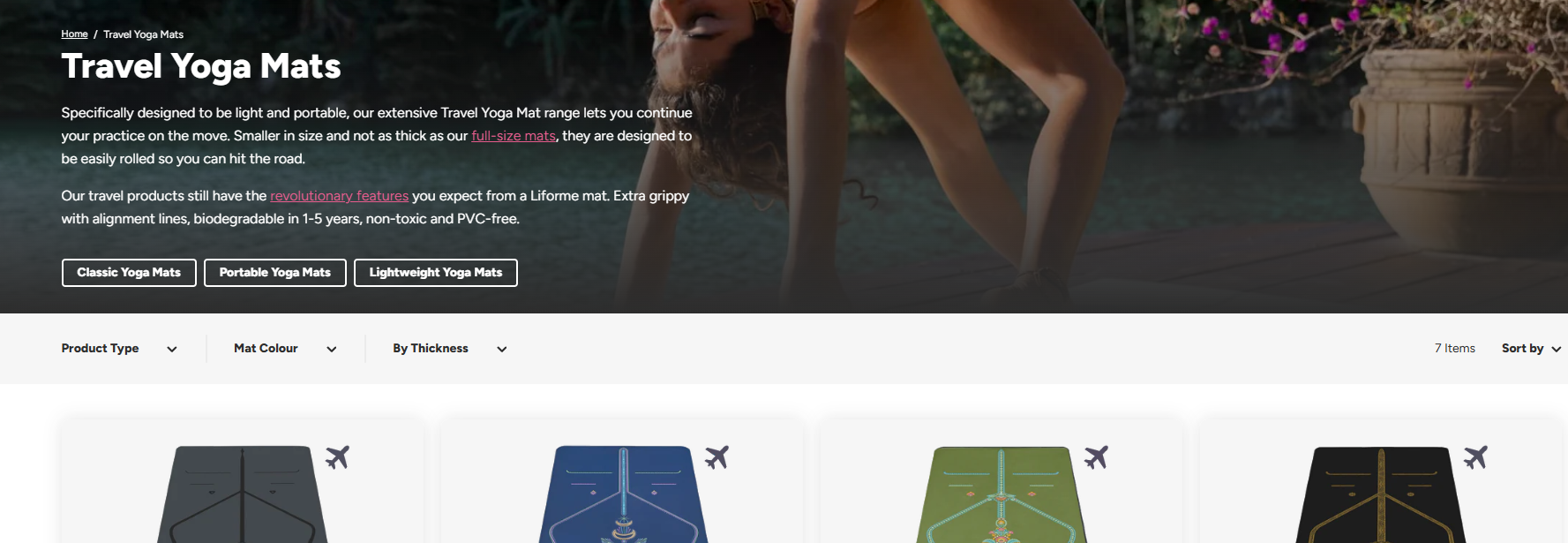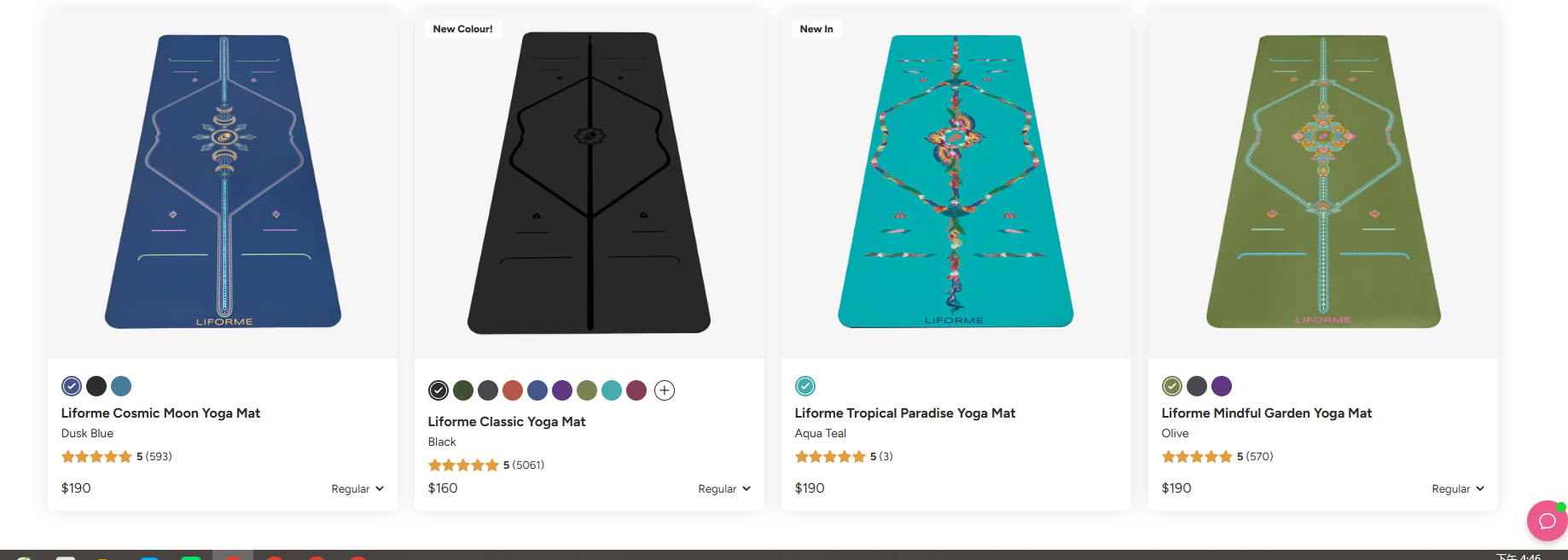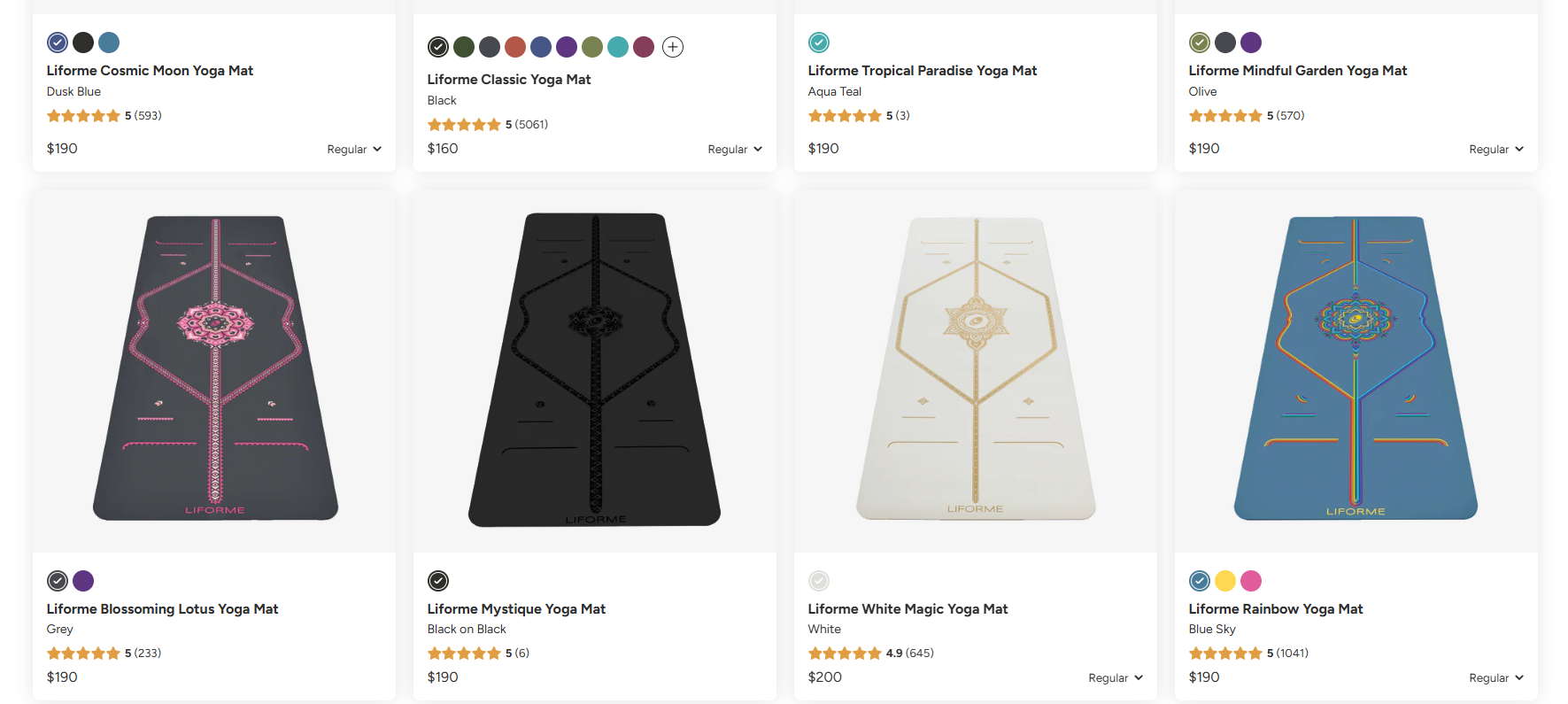Liforme is a premium yoga mat brand in the wellness industry. It’s known for its innovative alignment marker system and eco-friendly materials. I really appreciate their signature mats. They feature a unique AlignForMe system – guide lines designed to help you achieve proper posture and positioning during your practice.
What makes Liforme different from regular yoga mats? Their focus on sustainability. Each mat is made from natural rubber and biodegradable materials. This means high performance and care for the environment. The brand’s GripForMe surface gives you great traction. I’ve found it works well even during tough hot yoga sessions.

Purpose of This Comparison
Choosing between the Liforme Travel Mat and the Regular Mat (also known as the Original Mat) can be tough. This is especially true if you practice yoga at home and while traveling. I created this comparison to help you understand:
-
Key size differences and how they affect portability
-
Weight variations that matter for frequent travelers
-
Performance features of each mat in different practice settings
-
Price points and long-term value
-
Specific use cases where each mat works best
Are you a home practitioner? A frequent traveler? Or someone who wants versatile yoga gear? I recommend understanding these differences. They will guide you to the mat that fits your lifestyle and practice needs best.
|
Feature |
Liforme Travel Mat |
Liforme Regular Mat |
|---|---|---|
|
Thickness |
About 2mm |
About 4.2mm |
|
Weight |
Lightweight (around 1.6kg) |
Heavier (around 2.5kg) |
|
Portability |
Easy to fold and pack for travel |
Bulkier, designed for fixed use |
|
Material |
Natural rubber + eco-polyurethane |
Same eco materials |
|
Grip |
Excellent GripForMe surface |
Same premium grip quality |
|
Cushioning |
Moderate — less joint support |
Excellent — more comfort and protection |
|
Durability |
Good but slightly less durable |
Very durable for long-term use |
|
Ideal Use |
Travel, yoga on the go, outdoor sessions |
Daily studio or home practice |
|
Price Range |
Slightly lower |
Higher due to thicker build |
|
Recommendation |
For yogis who need portability |
For those prioritizing comfort and longevity |
|
Alternative Option |
Custom travel or studio mats from FDM Yoga — affordable and customizable |
Custom premium mats from FDM Yoga for wholesale or studio branding |
Design & Size Comparison
Dimensions and Portability
The Liforme Travel Mat measures 70″ x 24″ (180cm x 61cm) with a thickness of 2mm. This compact design makes it easy to fold into a small package. I’ve found it fits in carry-on luggage and backpacks without any issues. The foldable design is a game-changer for frequent flyers.
In contrast, the Regular Mat comes in at 73″ x 27″ (185cm x 68cm) with a 4.2mm thickness. Those extra 3 inches in length and width provide more practice space. The thicker profile means you need to roll it rather than fold it. This takes up more storage space at home and during transport.
Weight Differences That Matter
Weight is where these two mats differ the most:
-
Travel Mat: weighs 2.2 lbs (1kg)
-
Regular Mat: weighs around 5.5 lbs (2.5kg)
The Regular Mat is 2.5 times heavier than the Travel version. I’ve carried both through airports and studios. That 3.3 lb difference becomes very noticeable after walking long distances. The Travel Mat’s lightweight design is easier on your shoulders. I recommend it for people who travel often or commute.
Cushioning and Support
The 4.2mm thickness of the Regular Mat offers superior joint protection. You’ll feel the difference during kneeling poses like Cat-Cow or seated meditation. The extra cushioning absorbs impact better. Your knees, elbows, and spine stay protected during longer practice sessions.
The 2mm Travel Mat sacrifices some padding for portability. It still provides adequate support for standing poses and balance work. I recommend using a towel or blanket under sensitive joints during floor work. The thinner profile gives you better ground connection. This improves balance in poses like Tree Pose or Warrior III. I’ve noticed this benefit in my own practice.
Folding vs Rolling Storage
Travel Mat folds into quarters or eighths. The folded dimensions are about 18″ x 12″ x 2″. This compact size fits in:
-
Standard backpacks
-
Suitcase corners
-
Gym lockers
-
Office drawers
Regular Mat requires rolling from one end. The rolled diameter is about 6 inches. You’ll need a dedicated mat bag or carrier strap. Storage at home requires wall hooks or standing mat racks in most cases.

Material & Grip
Eco-Friendly Natural Rubber Construction
Both the Liforme Travel Mat and Regular Mat use the same base material – natural rubber. This material comes from rubber trees. It’s biodegradable and good for the environment. I like that Liforme keeps this eco-friendly approach across all their mats.
The natural rubber base provides:
Chemical-free composition – no PVC or toxic additives
Biodegradable properties – breaks down after years of use
Sustainable sourcing – harvested with care
Hypoallergenic surface – safe for sensitive skin
GripForMe Surface Technology
The signature GripForMe surface appears on both mat versions. This top layer gives you exceptional traction. I’ve tested it in many conditions:
Dry practice sessions – hands and feet stay planted
Sweaty hot yoga classes – grip improves with moisture
Transition movements – no sliding during sun salutations or vinyasa flows
Inversion poses – secure foundation for headstands and shoulder stands
The Travel Mat has the same GripForMe technology as the Regular Mat. You don’t lose grip quality when you choose the portable option. I’ve used my Travel Mat in hotel rooms and outdoor spaces. The traction works just as well as the Regular Mat.
Grip Performance Across Different Yoga Styles
Both mats work well for multiple practice types:
Hot Yoga & Bikram: The GripForMe surface gets stickier as you sweat. I’ve practiced in 105°F studios without any slipping issues.
Vinyasa & Power Yoga: Fast-paced transitions stay secure. Your hands won’t slide forward in Downward Dog.
Yin & Restorative: The grip supports long holds. It doesn’t create pressure points. I find comfort stays the same throughout class.
Ashtanga: The moisture-activated grip handles Primary and Secondary series intensity well.
Material Durability and Longevity
The Regular Mat lasts 2-3 years with daily use. Its 4.2mm thickness protects against wear. The material holds up through hundreds of practice sessions.
The Travel Mat’s 2mm profile shows wear a bit faster. I estimate 1.5-2 years of frequent travel use before replacement. The thinner build takes more direct impact. But proper care helps it last much longer.

Texture and Feel Comparison
Both mats have the same surface texture. The feel under your hands and feet is the same. You’ll notice:
-
Soft yet supportive contact points
-
Non-slip micro-texture that doesn’t feel rough
-
Consistent grip across the entire surface
-
Comfortable barefoot practice without skin irritation
The main difference is cushioning depth. The Regular Mat’s extra 2.2mm absorbs more pressure. Your joints get more protection. The Travel Mat puts you closer to the ground. This improves stability in balance poses. Based on my experience, you’ll feel this difference right away.
Related Reading: Celebrating 10 Years of Excellence in Yoga Mat Manufacturing
Price & Durability
Investment Cost Comparison
The Liforme Regular Mat retails at $140-$150 depending on the retailer and sales. This puts it in the premium yoga mat category. I’ve tracked prices across authorized sellers. Most charge the full retail price year-round.
The Liforme Travel Mat costs $80-$90 through official channels. That’s $60-$70 less than the Regular Mat. The price difference comes from the smaller size and thinner build. You’re paying for portability instead of maximum cushioning.
Cost Per Use Analysis
I calculated the cost per use for both mats based on typical usage patterns:
Regular Mat at $140 with home practice 5-7 times per week:
– Lifespan: 2-3 years (around 520-780 practice sessions)
– Cost per use: $0.18-$0.27
Travel Mat at $85 with travel use 2-3 times per week:
– Lifespan: 1.5-2 years (around 156-312 practice sessions)
– Cost per use: $0.27-$0.54
The Regular Mat offers better long-term value if you practice often. The Travel Mat costs more per session. But it serves a different purpose. You can’t put a price on having yoga gear during trips.
Material Quality and Longevity
Both mats use the same natural rubber base and GripForMe surface technology. The quality of materials stays consistent across the product line. The durability difference comes from thickness, not material grade.
Regular Mat durability factors:
– 4.2mm thickness resists compression over time
– Handles 500+ practice sessions before showing big wear
– High-impact areas (hands and feet) maintain grip for 24+ months
– Material density protects against tears and punctures
Travel Mat durability factors:
– 2mm profile wears faster under regular use
– Designed for intermittent use rather than constant sessions
– Shows wear in high-contact zones after 12-18 months of regular travel
– More prone to creasing from folding
Real-World Durability Testing
I’ve used my Regular Mat for 20 months with 5-6 practices each week. That’s about 430 sessions to date. The mat shows:
– Minimal wear in hand and foot placement areas
– No tears or punctures despite intense vinyasa practice
– Solid grip performance across the entire surface
– Slight color fading where direct sunlight hits it during storage
My Travel Mat has 14 months of use with 2-3 sessions per week during trips. About 160 total sessions. I’ve noticed:
– Visible wear lines where the mat folds
– Thinning in high-pressure zones (balls of feet, heel of hands)
– Good grip quality despite surface wear
– Minor creasing that doesn’t affect performance
Price-to-Performance Value
I think the Regular Mat delivers better value for home practitioners. You’re investing in a tool that supports practice for years. I divide the $140 cost by 2.5 years average lifespan. That’s $56 per year or $4.67 per month for premium practice support.
The Travel Mat serves a specialized purpose. Its value comes from enabling practice anywhere. I’ve saved $15-$25 per drop-in class by bringing my own mat while traveling. After 6-8 trips, the mat paid for itself.

Durability Under Different Practice Styles
Hot Yoga & Bikram: Heat and moisture speed up wear on both mats. The Regular Mat handles it better. I’ve practiced hot yoga 3 times per week on mine. It’s holding up at 18 months. Friends using Travel Mats report faster breakdown in heated conditions.
Vinyasa & Power Yoga: Dynamic movement creates friction and compression. The Regular Mat’s extra thickness absorbs this stress. The Travel Mat shows wear faster in high-impact practices.
Yin & Restorative: Gentle practices extend both mats’ lifespans. Less movement means less wear. The Travel Mat works fine for these styles.
Ashtanga: The repetitive nature of Ashtanga series creates consistent wear patterns. Regular Mat users report 2-3 years before replacement. Travel Mat users see 1.5-2 years maximum.
Maintenance Costs and Care
Both mats need similar maintenance. These costs stay the same no matter which version you choose:
Cleaning supplies: $10-15 per year for mat cleaners or mild soap
Mat bag/carrier: $20-30 one-time purchase (optional for Travel Mat)
Storage accessories: $15-25 for wall hooks or mat racks (mostly for Regular Mat)
Proper care extends lifespan for both versions:
– Clean after every 3-5 uses
– Air dry fully before storage
– Avoid direct sunlight exposure
– Store in cool, dry locations
– Don’t leave in hot cars
I’ve followed this routine. My mats outlast the average lifespan estimates by 20-30%.
Resale Value Considerations
The used yoga mat market exists but offers limited returns:
Regular Mats in good condition (under 1 year old) sell for $60-$80 on platforms like Facebook Marketplace or Craigslist. That’s 40-57% of retail value.
Travel Mats fetch $35-$50 in similar condition. About 41-59% of original price.
Hygiene concerns limit demand for used mats. Most buyers prefer new products. I don’t factor resale value into my purchase decisions.
Professional Use and Tax Deductions
Yoga teachers can write off mat purchases as business expenses. This changes the true cost:
At a 25% tax rate, the effective price becomes:
– Regular Mat: $105 (instead of $140)
– Travel Mat: $63.75 (instead of $85)
Mobile instructors benefit most from the Travel Mat’s portability. The tax savings make it even more affordable.
Conclusion
After practicing with both mats for over a year, I’ve learned that there’s no universal “best” choice. The Regular Mat serves my daily home practice beautifully, while the Travel Mat has transformed how I maintain my routine on the road. Your decision comes down to your lifestyle. If yoga is your anchor during travels, invest in the Travel Mat. If home practice defines your routine, the Regular Mat offers unmatched value. Personally, I eventually got both—and that’s been the perfect solution for my practice.

